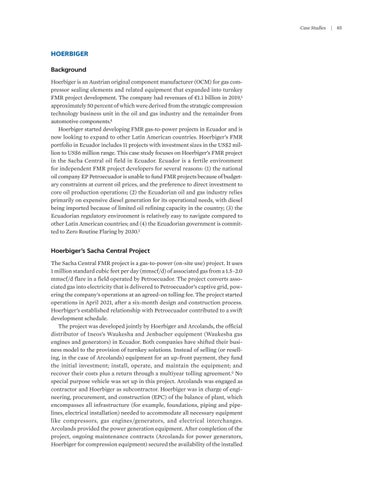Case Studies
HOERBIGER Background Hoerbiger is an Austrian original component manufacturer (OCM) for gas compressor sealing elements and related equipment that expanded into turnkey FMR project development. The company had revenues of €1.1 billion in 2019,3 approximately 50 percent of which were derived from the strategic compression technology business unit in the oil and gas industry and the remainder from automotive components.4 Hoerbiger started developing FMR gas-to-power projects in Ecuador and is now looking to expand to other Latin American countries. Hoerbiger’s FMR portfolio in Ecuador includes 11 projects with investment sizes in the US$2 million to US$6 million range. This case study focuses on Hoerbiger’s FMR project in the Sacha Central oil field in Ecuador. Ecuador is a fertile environment for independent FMR project developers for several reasons: (1) the national oil company EP Petroecuador is unable to fund FMR projects because of budgetary constraints at current oil prices, and the preference to direct investment to core oil production operations; (2) the Ecuadorian oil and gas industry relies primarily on expensive diesel generation for its operational needs, with diesel being imported because of limited oil refining capacity in the country; (3) the Ecuadorian regulatory environment is relatively easy to navigate compared to other Latin American countries; and (4) the Ecuadorian government is committed to Zero Routine Flaring by 2030.5
Hoerbiger’s Sacha Central Project The Sacha Central FMR project is a gas-to-power (on-site use) project. It uses 1 million standard cubic feet per day (mmscf/d) of associated gas from a 1.5–2.0 mmscf/d flare in a field operated by Petroecuador. The project converts associated gas into electricity that is delivered to Petroecuador’s captive grid, powering the company’s operations at an agreed-on tolling fee. The project started operations in April 2021, after a six-month design and construction process. Hoerbiger’s established relationship with Petroecuador contributed to a swift development schedule. The project was developed jointly by Hoerbiger and Arcolands, the official distributor of Ineos’s Waukesha and Jenbacher equipment (Waukesha gas engines and generators) in Ecuador. Both companies have shifted their business model to the provision of turnkey solutions. Instead of selling (or reselling, in the case of Arcolands) equipment for an up-front payment, they fund the initial investment; install, operate, and maintain the equipment; and recover their costs plus a return through a multiyear tolling agreement.6 No special purpose vehicle was set up in this project. Arcolands was engaged as contractor and Hoerbiger as subcontractor. Hoerbiger was in charge of engineering, procurement, and construction (EPC) of the balance of plant, which encompasses all infrastructure (for example, foundations, piping and pipelines, electrical installation) needed to accommodate all necessary equipment like compressors, gas engines/generators, and electrical interchanges. Arcolands provided the power generation equipment. After completion of the project, ongoing maintenance contracts (Arcolands for power generators, Hoerbiger for compression equipment) secured the availability of the installed
|
85
